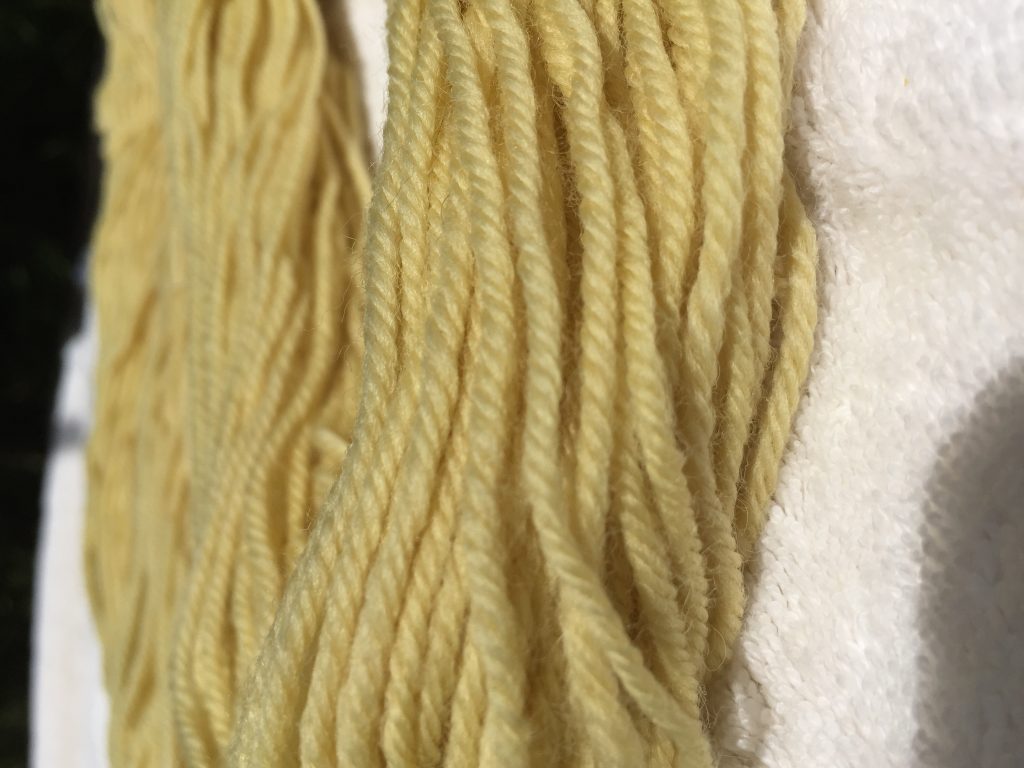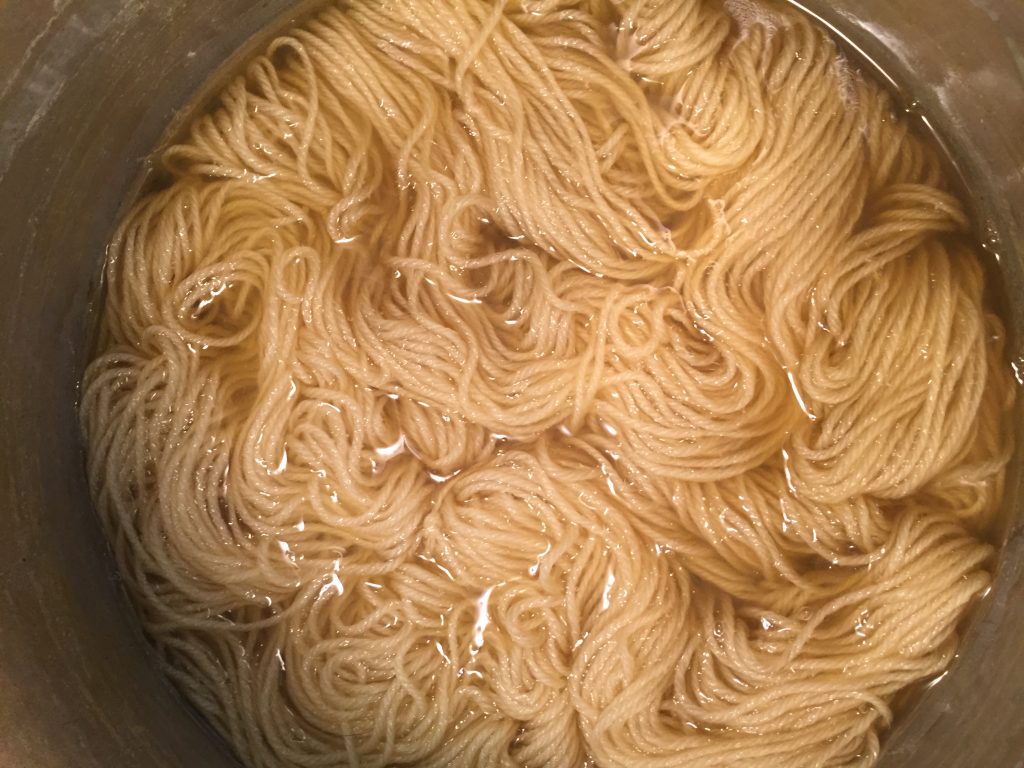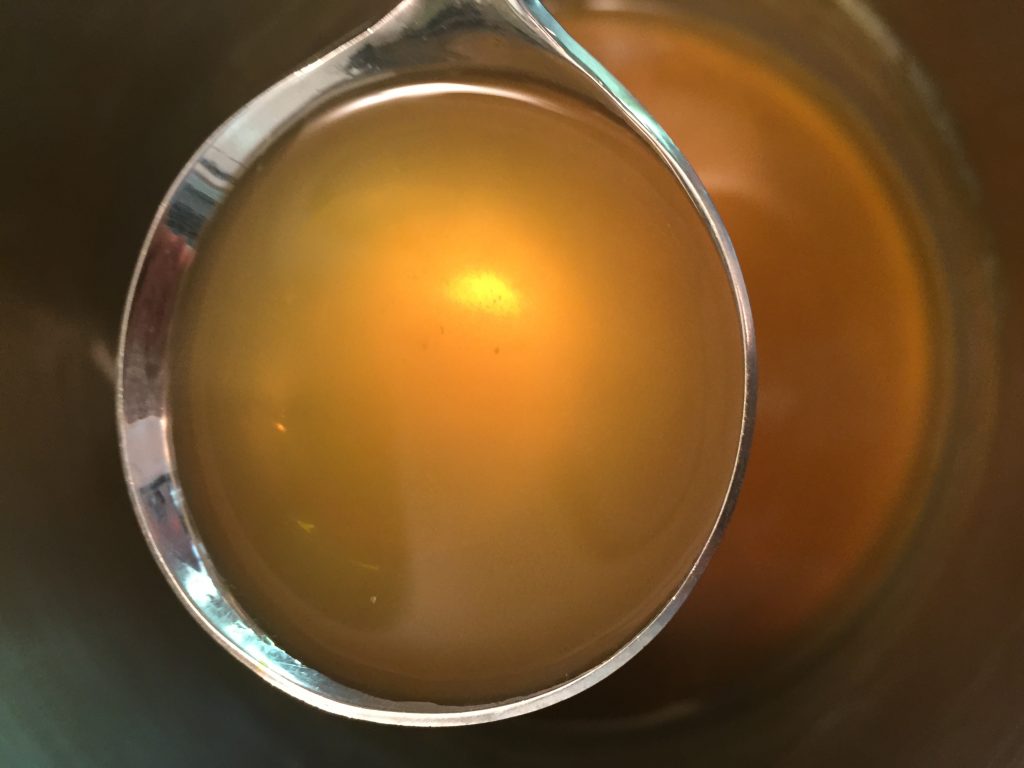It takes a bit of time, but it’s a super easy process. Learn how to dye yarn with dandelions in 4 simple steps and just 3 ingredients.

Okay, you all probably get sick of hearing how much I adore dandelions. How I’ve loved them since I was a kid (and back before it was cool to be a dandelion hugger!)
I do a little knitting here and there (and even crochet), and thought it would be awesome to see how dandelions dye wool. So I set about to learn. It’s a super easy project (the only ingredient you might have to buy is Alum and it’s cheap) and it’s fun to do.

Here’s the step-by-step directions on how to dye yarn with dandelions.
Step One: Collect Ingredients
The ingredient list is small for this natural, earthy project. You simply need
- Yarn (white wool yarn works best)
- Dandelion (the flower part)*
- Powdered Alum
- Water
You’ll also need a big non-reactive pot and stirring spoon as well as an old towel or two.
*As far as how many dandelions you should gather, that depends on the amount of yarn you want to dye and how deep you want the color. A general ratio is 2 parts dandelions to 1 part yarn. That means, if you have 3 oz of yarn, you’ll need 6 oz of dandelions (you will soon realize how LIGHT dandelions are and how MANY you need to pick to get a substantial amount of them). The dandelion collection and preparation is the hardest part, and luckily, you’ll get it out of the way right off the bat!

Step Two: Prepare the Dandelions
You’ll (mostly) just want the flower petals of the dandelion. Separate them from the stems and leaves and put them into a large heavy pot.
(For this process, it’s not as crucial to get every single little green speck removed from the dandelion petals (like it is with baking). However, having said that, the more ‘just petals’ you use, the nicer yellow you’ll get for your finished project.)
If you’d like a simple way to remove the petals from the greens, here’s how I do it…the key is to rip open the ‘bulby’ part of the base of the flower and puck the petals out (this is much easier than the popular chopping petals off and separating greens later):
Once you’ve got your dandelions, put them in a large, heavy pot with about 3 cups of water and bring to a boil before simmering for 2 hours.
Strain out the flower parts and reserve the dye to use for your yarn.
Step Three: Prepare the Yarn
In order for the dandelion ‘dye’ to change the color of the yarn (and have it stay that way after you wash it), you first have to prepare the yarn to accept the dye. This is done by soaking the yarn in a fixative that will help the dye bind to the fibers. (The technical name for this is mordant).
While there are different ways to accomplish this, I used Alum powder, which you can find in the baking section at the grocery store (it’s used in pickling).
**Note here: some suggest using a second-hand pot and utensils when dealing with any kind of mordant as well as gloves and goggles. Some fixatives are more toxic and caustic than others, so use caution**
There is no fast and hard rule about how much of the fixative/mordant/Alum to use. The advice I took was 8% Alum by weight, which translates into about 1 teaspoon of Alum for every 2 ounces of yarn used.

Measure out the Alum and dissolve it in a cup of hot water. Add this and enough water to your pot to cover the yarn. Add yarn, stir slightly until coated and covered. Bring this to a slow boil, then simmer 45 minutes. Allow the yarn to cool in the water before removing it.
Once it’s cool, if you’re going to use it immediately, the yarn is ready to add to the dandelion dye.

Step Four: Dyeing Your Yarn
Finally! It’s time to dye! Add the dye and your yarn to the non-reactive pot and bring to a light boil before simmering for an hour or so.
Turn off the heat and let it all cool. If you’re using natural fibers (wool) don’t move it around much or you could cause it to felt.
Once everything is cool, remove the yarn, rinse it in warm-ish water and hang to dry.

Do you like all-things dandelion like I do? If so, here are some other great things to try using dandelions:
Rhubarb Dandelion Pie (a spring tradition for me! I LOVE IT)
Dandelion Lip Balm(my friends tell me it’s their favorite lip balm EVER)
Dandelion Jelly (it’s cheery bright yellow and tastes a lot like honey)
Dandelion Salve (this anti-inflammatory salve is good for achy muscles and for soothing skin)
Dandelion Cookies(a basic, sensible cookie with dandelion petals mixed in)
Dandelion Pesto (‘Italian greens’)
